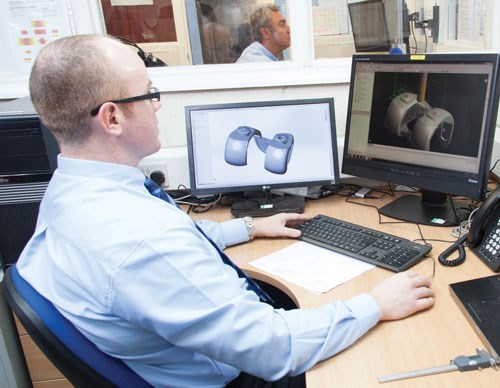Software Creates Perfect Tool Paths for Five-Axis Machining
A week’s programming with Edgecam CNC software provides a U.K. manufacturer of orthopaedic instruments with 12 weeks of machining time for its highly complex products.
A week’s programming with Edgecam CNC software provides a U.K. manufacturer of orthopaedic instruments with 12 weeks of machining time for its highly complex products.
Staff at Sheffield Precision Medical says it could not have physically produced many of last year’s 50,000-piece parts without Edgecam. According to Manufacturing Director Steve Lambell, its products are so complex that it would be impossible to write CNC programs for them manually.
“There would be thousands of lines of code. We just couldn’t do it. Many of our Edgecam programs are for milling 3D surfaces on Bridgeport and Haas three-, four- and five-axis machines,” Mr. Lambell says. “We carry out all our positional work with five axes. Previously, we would have needed to make fixtures to hold the parts in the right orientation, but Edgecam creates perfect tool paths for five-axis machining, saving us about 60 percent on setup time.”
Working closely with major medical and surgical companies such as DePuy, Biomet, and MatOrtho, Sheffield Precision Medical’s range runs to several hundred different products, including drills, reamers, rasps, guides and cutters, in varying sizes. “We’ll get the programs right for one size, and then Edgecam quickly produces tool paths for the other sizes,” Mr. Lambell says. “This is vital for getting full machine utilization and optimum floor-to-floor time from when we first pick up the job at the design stage to putting the finished product on the floor.”
Managing Director Brian Reece says the company’s roots as a cutting tool manufacturer are a great strength. “Many surgical instruments are very similar to an ordinary cutting tool, and when we moved into this sector in 1990 our understanding of cutting tool technology enabled us to redesign new customers’ existing instruments to make them more efficient and produce them with fewer components.”
These days, orders vary from one specific instrument to complete sets of everything a surgeon needs to carry out operations such as hip, elbow and shoulder joint replacements.
“We often get involved at the prototyping stage,” Mr. Reece says. “It may be a concept, or may be an actual prototype that a customer has an issue with regarding manufacturing it in the most cost-effective way. That’s where our background in cutting tools pays dividends, enabling us to use our technological knowledge for the design itself, to produce the best instruments. And Edgecam is key to the front end design, which actually spearheads our business.”
Most customers provide a 3D model, which Sheffield Precision Medical then pulls into Edgecam and extracts features for creating the cutting paths. “The features are mainly profiling, roughing and parallel lace (or scanning) where we run the bullnose over the 3D contour for all the 3D shapes,” Mr. Reece says.
Mr. Lambell says when the raw billet first goes on the machine, Edgecam produces the roughing cycle on its own, before they move on to finishing. “We do it this way because some of our programs have more than 25 tools, each relating to a different profiling operation,” he says. “Posting the roughing and finishing programs one at a time makes it easier for the operator to understand, and it’s a lot smoother to get the machine up and running.”
Mr. Lambell and a colleague program all the jobs, with six setup operators, then set up the tooling, prove the programs and run the machines.
“We always run a simulation on Edgecam in the office before sending the program to the machine, and, as a result, we’ve never had a collision.”
The simulation function also plays an important part in showing the finished surface texture. “We can actually see what it’s going to be like before we start machining. It’s all to do with tolerancing on the profiling, roughing or parallel lace. By using the true simulation, we can see an extremely accurate replication of the surface finish the machine will give us.”
Mr. Lambell does not believe his company is a “typical” Edgecam user because of the range of different shapes and sizes it manufactures and the complexity of the shapes. “Some of the parts we make never have a 90-degree edge to one another,” Mr. Lambell says. “Sometimes when we get an order for a new product, we can’t see at first how we’re going to make it. But running a program through Edgecam to create a profiling operation is done in minutes, making our production process so much easier. I don’t work to solid; I extract the information I need off the solid to run the cutters.”
Read Next
5 Aspects of PMTS I Appreciate
The three-day edition of the 2025 Precision Machining Technology Show kicks off at the start of April. I’ll be there, and here are some reasons why.
Read MoreA Tooling Workshop Worth a Visit
Marubeni Citizen-Cincom’s tooling and accessory workshop offers a chance to learn more about ancillary devices that can boost machining efficiency and capability.
Read MoreEmerging Leaders Nominations Now Open
Here’s your chance to highlight a young person in your manufacturing business who is on the path to be a future leader moving your company forward.
Read More












.jpg;maxWidth=300;quality=90)









